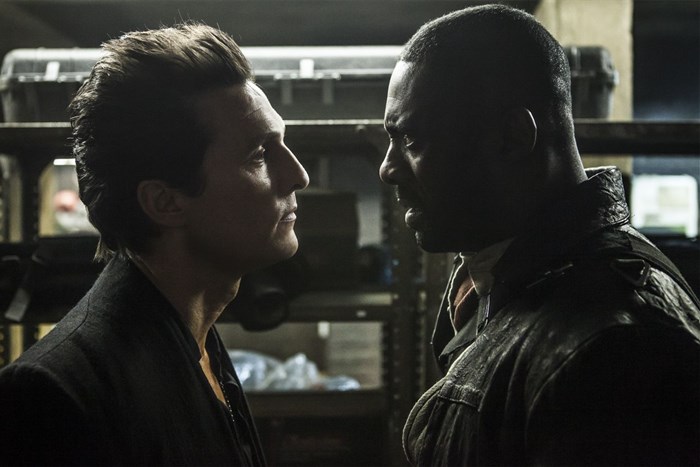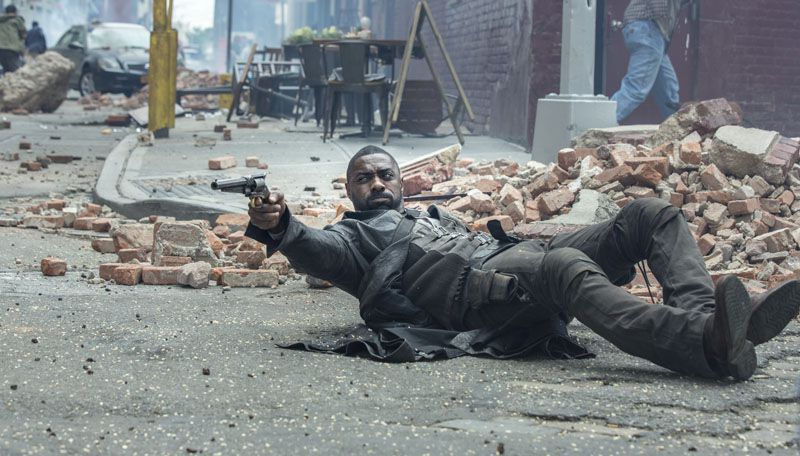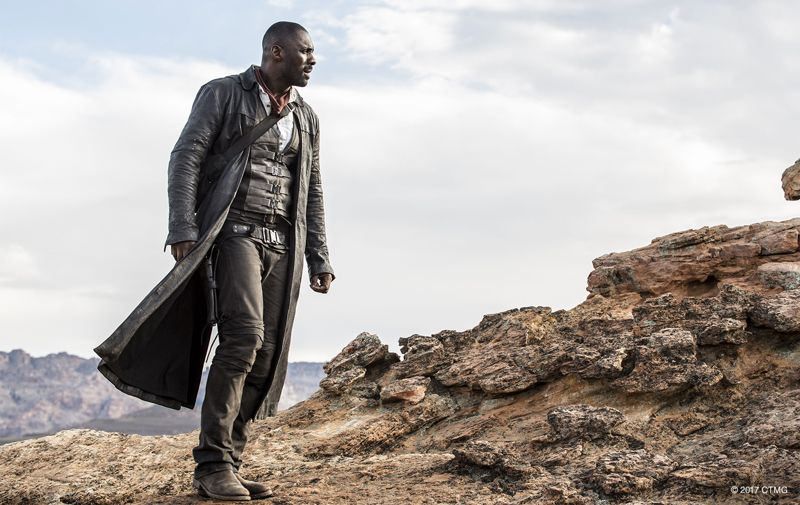





A gunslinger and a man in black
In The Dark Tower, the last gunslinger Roland Deschain (Idris Elba) has been locked in an eternal battle with Walter O’Dim, also known as the Man in Black (Matthew McConaughey). Deschain is determined to prevent the Man in Black from toppling the Dark Tower, which holds the universe together. With the fate of the worlds at stake, good and evil collide in the ultimate battle as only Deschain can defend the Tower from the Man in Black.

It’s an epic that has inspired millions of readers – not least of which was a young boy in Denmark whose imagination was sparked by the events in Mid-World. Director Nikolaj Arcel was determined to be the one to bring The Dark Tower to the screen.
Arcel’s vision was to try to stay true to King’s “mix of modern day and the fantastic…(as it’s) what Stephen King does best.”
The fantastical elements in The Dark Tower could take care of themselves, but Arcel sought to keep it grounded in reality. ”We had to keep it real; this world is so immense and so complex, and in the novels, at times, even abstract. I really wanted Mid-World, the characters and everything to feel as real as every day. I didn’t want to have some kind of lofty genre and have everyone speaking in odd ways. I wanted it to feel like anybody could take this journey to Mid-World, and understand it, and be there, and feel that these are real people.”
Arcel and his cinematographer Rasmus Videbaek reteam for the fifth time with The Dark Tower.
Bodil (the Danish equivalent of the Academy Award) award-winner Videbaek says, “There are vastly different visuals in the movie: we move from the intimacy of Jake’s small apartment where our cameras are psychologically close to him, as if trying to get into his head, and then when this little guy arrives in an enormous new world, we move to wide epic shots in a blindingly bright desert.”

As many of King’s works are, the film is grounded in reality with supernatural elements hidden in the everyday world. The visual interpretation of the author’s worlds was in the hands of production designer Christopher Glass. “Our main goal was to transport people right into Stephen King’s world,” says Glass.
With the story set in both modern day New York and in Mid-World, Arcel sought to contrast the two worlds, with the Tower providing the connection. “I wanted to visually present the modern day world in a grounded and intimate way – we’re just being with Jake and the other characters in his life there.”
After the first 15 minutes of the film, it would open up and expand, he says, “like a CinemaScope experience, with John Ford full-scale vistas”.
Glass says that contrasting Mid-World and our world is a designer’s dream. “There are so many diverse landscapes and scenes, and a journey and a progression that travels from New York City to Mid-World, and to the Tower itself,” he says. “It’s fun to create a world that combines strange with ordinary at the same time, mixing normalcy with stuff that’s a little bit off.”
Glass says that his greatest challenge was trying to match King’s layered and complex vision to create an entire world. “It’s always a challenge when you are interpreting somebody else’s writing and a very popular series of novels with graphic images,” he notes.

“The difficulty is because you need to live up to the source material – which we don’t want to betray – but at the same time making it something that contemporary audiences would find new and exciting. Fans have their own ideas of what these worlds look like, so there’s been a lot of speculation and anticipation, and it was our job in making the movie to fill that void.”
Arcel describes Mid-World as a more fantastical version of Earth. “It’s a world parallel to ours. It looks different from Earth – it’s otherworldly, with alien landscapes and a barren wasteland, and the characters who live there are very different from us: they’re gunslingers, sorcerers, creatures, monsters.”
Part of the film was shot on location in South Africa, which offered unique landscapes and awe-inspiring forests for the alternate dimension. The production took the company to such remote places as the barren Karoo desert, where they built the Mid-World sets. To add a further layer of a parallel universe, the company moved to the Cedarburg mountain range, where the protected nature reserve features dramatic caves and characteristic red rocks.
“Mid-World is a sort of a wasteland, yet not quite,” says Glass. “There are a lot of remnants of an ancient civilization that are scattered around this place; weirdly, the civilization is a future civilization that has now become ancient.”
“In South Africa, we found otherworldly deserts – it was almost like being on Mars,” Glass continues. “The horizon just kept going; I’ve never seen anything like that before. I think that there’s a romance and a certain sense of adventure that goes into filming in Africa.”

The location of the Manni Village was found in a wine farm area just outside Cape Town. Here, in a valley almost hidden against a dramatic mountain drop, the filmmakers built the village - a refuge for a group of survivors of war looking for safety from the world. The Manni are simple people, struggling to survive through sustenance living.
“Nik described the Manni as a cross between Amish and something more tribal,” says Glass. “Nik wanted realism, something very similar to the Dust Bowl in America in the 1930s, an existence like The Grapes of Wrath. We referenced Andrew Wyeth paintings for the colour palette and the spartan nature of how they live.”
To create such a unique society, Glass researched cultures all over the world, from areas ranging from Mongolia to Eastern Europe to Siberia to the extreme and remote places like the Artic circle where people eke out a living.
It took the art department two months to build Glass’s dystopian architecture, including a village square, surrounded by the wooden houses of the town folk. “We consciously chose to make it earth tones, which definitely fit in with the hills and the mountains around us, almost like a camouflage so that they villagers are unseen and feel secure from the threats out there in the big world.”
And then there are the places where our world and Mid-World collide – for example, the Dixie Pig, where the vampires and the Taheen creatures can be found hanging out in New York City.
The Dixie Pig is a small city within a city. In Cape Town, the filmmakers located an abandoned shopping mall with multiple levels and spiralling ramps like a parking structure. The monstrous set consists of layers of floor levels, basement to rooftop, mazes of corridors and small rooms for the vendors involved in strange work.
Generally, the filmmakers sought to keep the design grounded, but for the Dixie Pig, all bets were off. “It’s one of the few sets where we could go a little crazier,” says Glass.
By constructing a 360° set, Glass says that he was able to provide atmosphere, but also give Arcel the freedom to shoot from any angle. “We dressed every corner. We could shoot in every direction, and even continue down to the next level and get all the shooting and gunfire action and explosions right. Every action beat was different, so we had to solve this creatively.”
The set was also vital because it would be the setting for the film’s climactic battle. “It’s the culmination of the movie, where Walter and Roland come face to face. Walter knows that Roland is on his way, so they’re readying for battle.”
The film’s extras casting director added another layer of King’s multi-dimensional cast of characters for background and bit parts, populating the Dixie Pig with workers in a psychiatric hospital, Taheens learning human language in the school, and blood-drinking vampires.
“I searched for weird, wonderful and interesting faces with special features, an eclectic bunch, people you wouldn’t want to meet in a dark alley,” says Merrimen. “We had to make sure that they would scare and intimidate. We went as far as rehearsing them in different areas of the set to match them for hair colour and eyebrow tints, especially for the vampires.”
Design and creation of the Taheen creatures and Trackers fell to Graham Press and Clinton Aiden Smith, respectively.
The Dark Tower opens at South African cinemas on 8 September 2017.
